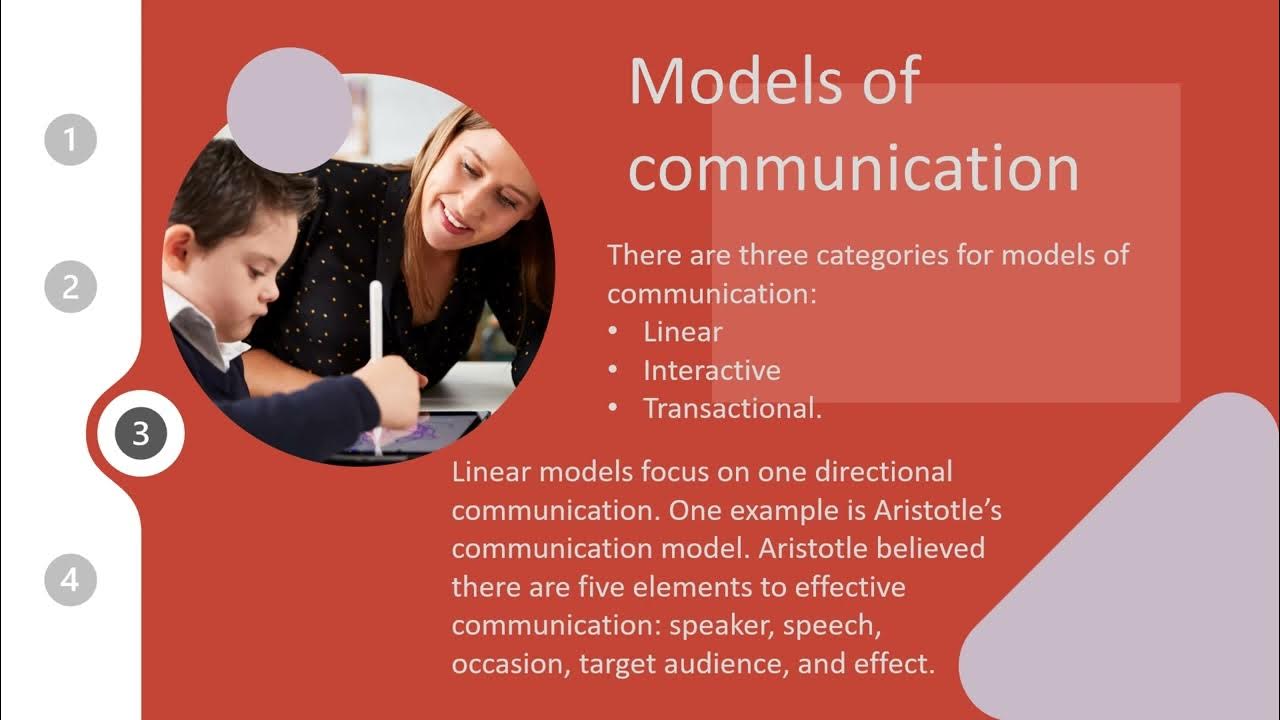Lesson 2: Models of Communication | Oral Communication in Context
Summary
TLDRThis video script delves into various models of communication, tracing their evolution from Aristotle's simple three-part model to contemporary theories. It highlights the Shannon-Weaver model's identification of 'noise' as a disruptor, Lasswell's model emphasizing communication's societal functions, and Schramm's cyclical interaction concept. The script also covers models focusing on encoding and decoding, like Berlo's SMCR, and explores the dynamic, evolving nature of communication as presented in Dance's helix model and the symbolic interaction model. Finally, it underscores the importance of feedback in the speech communication transaction model, which views communication as an interactive, two-way process.
Takeaways
- 🗣️ The Aristotelian model is one of the earliest communication models, emphasizing the speaker's role in influencing the audience and is still relevant in public speaking today.
- 📞 The Shannon-Weaver model, known as the 'mother of all communication models,' introduced the concept of 'noise' and was originally designed for telephone communication but has broader applications.
- 🔍 Harold Lasswell's model highlights the three societal functions of communication: surveillance, correlation, and cultural transmission, showing communication's importance in societal structure and evolution.
- 🔁 Wilbur Schramm's model introduces the cyclical nature of communication, emphasizing the continuous interaction between sender and receiver.
- 🔠 David Berlo's SMCR model focuses on the elements of communication: Source, Message, Channel, and Receiver, and the characteristics that influence each element.
- 🎯 White's model outlines a step-by-step process in communication, stressing the importance of each stage from thinking to monitoring in the communication cycle.
- 💃 The Dance model by Frank Dance views communication as an evolving process, represented by a spiral, indicating that past communications influence future interactions.
- 🤝 The Symbolic Interaction model underscores the dynamic and systemic nature of communication, where personal meanings are constructed through symbolic interactions.
- 🔄 The Speech Communication Transaction model is a two-way process that emphasizes feedback, interaction, and the collaborative exchange of messages between communicators.
- 🚧 The script also discusses barriers to communication that can disrupt or stop the communication process, highlighting the need to be aware of and overcome these obstacles.
Q & A
What is the Aristotelian model of communication?
-The Aristotelian model of communication is one of the earliest communication models, proposed by Aristotle. It is a simple, one-way model that involves three elements: the speaker, the speech or message, and the audience or listener. The speaker delivers a message intended to influence the audience, making the speaker the most crucial element in this model.
Why is the Aristotelian model of communication still relevant today?
-The Aristotelian model of communication is still relevant today because it is considered the golden rule for public speaking. In contexts like classrooms, lectures, and seminars, where the speaker needs to influence and captivate the audience, this model is particularly applicable.
What is unique about the Shannon-Weaver model of communication?
-The Shannon-Weaver model of communication, also known as the mother of all communication models, is unique because it was the first to introduce the concept of 'noise'—factors that can disrupt the communication process. Originally designed for telephone communication, it is a linear, one-way model that highlights the transmission and reception of messages.
How does the Lasso model of communication differ from earlier models?
-The Lasso model of communication, proposed by Harold Lasswell, differs from earlier models by emphasizing the functions of communication in society, such as surveillance, correlation, and cultural transmission. It is a verbal, one-way model that focuses on how communication is used to inform, influence, and transmit culture within society.
What are the three functions of communication according to Harold Lasswell's model?
-According to Harold Lasswell, communication serves three primary functions in society: surveillance (alerting society to potential threats), correlation (helping society interpret and respond to these threats), and cultural transmission (passing on values, norms, and traditions from one generation to another).
What does the Schramm model of communication introduce that is different from previous models?
-The Schramm model of communication introduces the idea of communication as a cyclical, ongoing process involving continuous interaction between the sender and receiver. It was the first model to emphasize the notion of process and interaction, where the roles of sender and receiver are interchangeable.
What is the SMCR model in Berlo's model of communication?
-The SMCR model, proposed by David Berlo, stands for Source, Message, Channel, and Receiver. This model focuses on the encoding and decoding processes and considers various factors like communication skills, attitudes, knowledge, social system, and culture that influence the communication process.
What does White's model of communication emphasize?
-White's model of communication emphasizes a step-by-step sequence of events in the communication process. It suggests that communication involves specific steps like thinking, symbolizing, expressing, transmitting, receiving, decoding, feedbacking, and monitoring, and these steps must be followed in order.
How does the Dance model of communication describe communication?
-The Dance model of communication, represented by a spiraling helix, describes communication as a dynamic and evolving process that moves forward and backward. It emphasizes that what we communicate now can influence future communication and behavior, reflecting the ongoing and changing nature of communication.
What is the significance of feedback in the Speech Communication Transaction model?
-Feedback is crucial in the Speech Communication Transaction model because it transforms communication into a two-way, interactive process. This model highlights the importance of feedback in ensuring that communication is effective and that both the sender and receiver are actively engaged in the communication process.
Outlines

هذا القسم متوفر فقط للمشتركين. يرجى الترقية للوصول إلى هذه الميزة.
قم بالترقية الآنMindmap

هذا القسم متوفر فقط للمشتركين. يرجى الترقية للوصول إلى هذه الميزة.
قم بالترقية الآنKeywords

هذا القسم متوفر فقط للمشتركين. يرجى الترقية للوصول إلى هذه الميزة.
قم بالترقية الآنHighlights

هذا القسم متوفر فقط للمشتركين. يرجى الترقية للوصول إلى هذه الميزة.
قم بالترقية الآنTranscripts

هذا القسم متوفر فقط للمشتركين. يرجى الترقية للوصول إلى هذه الميزة.
قم بالترقية الآن5.0 / 5 (0 votes)






